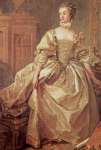18th Century: Late Baroque and Rococo

|
|

The High Baroque of the later 17th century - led by the court of Louis XIV - gave rise to a stylised, even ritualised way of life of the upper class, who begin to feel their private lives encroached upon by court duties and subsequently develop a yearning for a simpler way of life.
 During
the early 18th century there emerged a highly romanticised view of country life
as being free of the rules and regulations that ruled the court, with the sheperds
and sheperdesses, nymphs and fauns of ancient Greek legend as a model. Renderings
of lower class life can therefore not be regarded as accurate anymore; any shepherdess
encountered in an 18th century painting is suspect of being a "countrified"
court lady. In fact, many members of the nobility had their portraits painted
in "shepherdess" costume.
During
the early 18th century there emerged a highly romanticised view of country life
as being free of the rules and regulations that ruled the court, with the sheperds
and sheperdesses, nymphs and fauns of ancient Greek legend as a model. Renderings
of lower class life can therefore not be regarded as accurate anymore; any shepherdess
encountered in an 18th century painting is suspect of being a "countrified"
court lady. In fact, many members of the nobility had their portraits painted
in "shepherdess" costume.
Whenever you encounter a painting of a scene set in a landscape rather than closed rooms, it can be suspected of depicting a fantasy scene or at least a party of members of the upper class dressed up as sheperds and shepherdesses. Watteau often painted people theatrical (comédie) costumes; few of his paintings can be trusted. Even if the setting is inside a room, be careful! Especially during the early 18th century we often see people in mask or allegorical costume. A mask in hand hints at a masked ball costume, arrows and bows in a lady's hand at her having dressed up as the goddess Diana. These costumes may all have existed in reality and may be taken as documents of what people wore to balls, but they were not worn for everyday occasions.
 The
morbid tendencies of the baroque lingered (in some regions, Rococo is even identified
with late Baroque), as did the contrasting enjoyment of life, which now clearly
prevailed, with symbols of mortality as mere counterweight.
The
morbid tendencies of the baroque lingered (in some regions, Rococo is even identified
with late Baroque), as did the contrasting enjoyment of life, which now clearly
prevailed, with symbols of mortality as mere counterweight.
Paintings tend to use muted, cool colours. The background is light while the middle distance is dark (i.e. the contrary of Baroque paintings) and the foreground figures in the light. The shininess, weight and patterns of textiles can still be considered accurately rendered, but details become less important. Pastel chalk, which forbids both mixing pigments for exact colour rendering and clearly defined lines, gains popularity and gives a soft apperance to portraits.
The most useful painters are Boucher, Fragonard, Liotard, Reynolds, Hogarth, Gainsborough. Nattier and Chardin depict the working class in a way that does not appear to be romanticised. Be aware that many portraits were in fact painted by more than one artist: The known painter, who did the overall composition, faces and hands, and the drapery painter, who put in the costume later. As drapery painters were highly specialised and experienced with anything textile, such portraits are no less credible as sources of costume study. Their rendering of the textiles - their shininess, stiffness, pattern - and of the current fashions is probably even better than anything done by a non-specialised painter.
| BEGIN >>> |